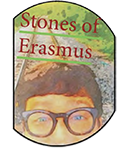$3
Janus | Roman Myth Series for Middle and High School ELA and Humanities 8-10
Bring Roman Mythology to Life with Janus and Jana — A Two-Day English Language Arts Lesson Your Students Won't Forget!
Explore the fascinating myth of Janus and Jana, conjoined Roman deities who look both backward and forward, symbolizing beginnings, endings, and life's essential transitions. Whether you're teaching Virgil, Ovid, Edith Hamilton's Mythology, or exploring ancient cultures in your humanities curriculum, this carefully crafted lesson pack engages middle and high school students through interactive reading cards, thought-provoking writing prompts, dynamic question sets, and collaborative activities.
This Resource Includes the Following Features:
- PDF, Google Workspace (Slides)
- Two-day Lesson Calendar
- With a teacher-tested stamp of approval, follow my suggestions on how to teach Janus in a two-day block with room for extension activities.
- 1 Key Characters and Concepts Anchor Chart
- Orient your learners by identifying the story's key characters and concepts with an illustrated anchor chart.
- 5 Illustrated Reading Cards
- Entry on “Janus and Jana” (Dictionary of Greek and Roman Biography)
- The Original Numina: Indigetes dii and the Earliest Roman Deities
- Lares and Penates
- Other Roman Gods of Boundaries, Rustic Realms, and Seasonal Feasts
- Saturn
- Ops
- Pales
- Terminus
- Manes
- Priapus
- Numa Pompilius (Legendary King of Roman)
- The Temple of Janus Quadrifrons
- Reading Protocol for a Jigsaw activity
- The card set includes nine illustrations from art, history, and other public domain sources.
- 30-Count Question Bank
- Either use these questions as a quiz after reading or check for students' understanding at the beginning of class.
- Frayer Model Vocabulary Template
- Frayer models are a way to get kids to think about vocabulary visually in a four-section square — A square for meaning, one for examples, another for non-examples, and a sketch.
- 2 Half-Sheet Exit Tickets (with academic choice)
- Exit tickets are a way to get data about your students' understanding of the lesson right before the class is finished. Collect these exit tickets and quickly see what essential ideas and text connections your students made.
- 2 Note-taking Sheets
- 3-Box Cornell Notetaking Template
- Note-taking Sheet (Illustrated for Janus and Jana)
- 1 Further Reading List
- Don't disregard this further reading list if you think it is merely a bibliography. Share the list with your students or have them do projects based on the available research. Assign different sources to students and organize presentations where learning can go deeper into this important Roman myth.
- Answer Keys for all student-facing documents
- Teachers always ask for answer keys for my products, so I gave you plenty of guidance on what to expect from students in their written and oral responses. Also includes student sample work.
Students will:
✓ Read multiple versions of the Janus myth, building critical thinking through comparison.
✓ Learn key vocabulary in context, enhancing language skills aligned with Common Core Standards (Includes a nifty alignment chart).
✓ Collaborate with classmates to discuss how myths shape language, culture, and personal identity.
✓ Write reflectively and analytically about the role of Numina—divine spirits who governed every aspect of Roman life—from domestic protection (Lares and Penates) to daily rituals.
✓ Connect mythology to real-world examples, such as understanding why January symbolizes new beginnings, or why the word "terminal" reflects Roman concepts of boundaries and limits.
Classroom-tested and ready-to-use, this resource invites adolescents into lively discussions about mythology's lasting impact on modern language, culture, and human experience. All materials are thoughtfully designed to ignite curiosity, foster deeper connections, and make ancient stories relevant to young learners today.
Digital Download: Ready-to-implement two-day lesson plan—everything you need to transform your humanities classroom into a space of inquiry and discovery.
Note: This resource includes original materials and is free from copyrighted content.
Educational Standards: This resource aligns well with the reading literature standard: "Analyze how a set of texts draw on themes, patterns of events, or character types from myths, traditional stories" and from other works of World Literature. I created this resource with middle and high school students in mind. It is designed for an English Language Arts or Humanities-based classroom. Use with The Aeneid, Fasti, Metamorphoses or Edith Hamilton's Mythology.
